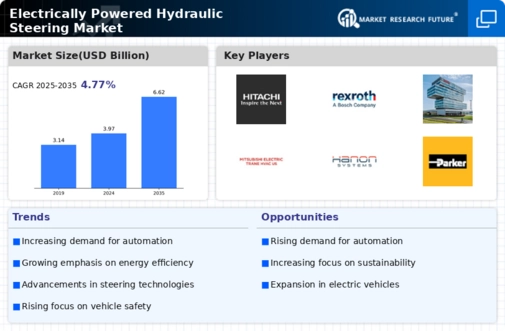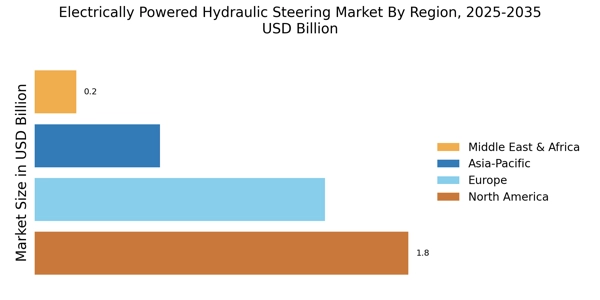Sustainability and Environmental Regulations
The Electrically Powered Hydraulic Steering Market is increasingly influenced by sustainability initiatives and stringent environmental regulations. Governments are implementing policies aimed at reducing carbon emissions, which encourages the adoption of electric steering systems that are more energy-efficient compared to traditional hydraulic systems. This shift aligns with the automotive industry's broader commitment to sustainability, as electric steering systems can contribute to lower fuel consumption and reduced greenhouse gas emissions. As a result, the market is expected to expand, with a notable increase in the production of electric vehicles equipped with advanced steering technologies. The Electrically Powered Hydraulic Steering Market is thus positioned to benefit from these regulatory changes, fostering innovation and growth.
Cost Efficiency and Manufacturing Innovations
Cost efficiency is a critical driver in the Electrically Powered Hydraulic Steering Market, as manufacturers seek to optimize production processes and reduce costs. Innovations in manufacturing techniques, such as automation and advanced materials, are enabling companies to produce steering systems more efficiently. This not only lowers production costs but also enhances the quality and reliability of the final product. As competition intensifies, manufacturers are likely to invest in these innovations to maintain profitability while meeting the growing demand for electric steering systems. The Electrically Powered Hydraulic Steering Market is thus positioned for growth, as cost-effective solutions become increasingly important in a competitive landscape.
Technological Advancements in Steering Systems
The Electrically Powered Hydraulic Steering Market is experiencing a surge in technological advancements that enhance vehicle performance and driver experience. Innovations such as advanced sensors and control algorithms are being integrated into steering systems, allowing for improved responsiveness and precision. These advancements not only contribute to better handling but also enhance safety features, making vehicles more reliable. The market is projected to grow at a compound annual growth rate of approximately 6% over the next five years, driven by these technological improvements. As manufacturers invest in research and development, the Electrically Powered Hydraulic Steering Market is likely to witness the introduction of more sophisticated systems that cater to the evolving demands of consumers.
Consumer Demand for Enhanced Driving Experience
Consumer preferences are evolving, with a growing demand for vehicles that offer enhanced driving experiences. The Electrically Powered Hydraulic Steering Market is responding to this trend by developing systems that provide better feedback, responsiveness, and comfort. Modern drivers are increasingly seeking vehicles that not only perform well but also offer a sense of connection to the road. This demand is driving manufacturers to innovate and improve steering technologies, leading to a more engaging driving experience. As a result, the Electrically Powered Hydraulic Steering Market is likely to witness increased competition among manufacturers striving to meet these consumer expectations, ultimately benefiting the market as a whole.
Integration with Autonomous Driving Technologies
The rise of autonomous driving technologies is reshaping the Electrically Powered Hydraulic Steering Market. As vehicles become increasingly automated, the need for precise and reliable steering systems becomes paramount. Electrically powered hydraulic steering systems are well-suited for integration with autonomous technologies, providing the necessary feedback and control for safe navigation. This trend is expected to drive significant investments in the development of steering systems that can seamlessly interface with advanced driver-assistance systems (ADAS). The Electrically Powered Hydraulic Steering Market is likely to see a substantial increase in demand as automakers prioritize the development of vehicles that can operate autonomously, thereby enhancing the overall driving experience.


















Leave a Comment